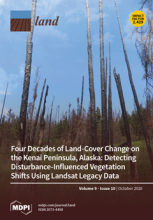Land Library
Welcome to the Land Portal Library. Explore our vast collection of open-access resources (over 74,000) including reports, journal articles, research papers, peer-reviewed publications, legal documents, videos and much more.
/ library resources
Showing items 1 through 8 of 8.Planning the adaptation of agriculture and forestry landscapes to climate change remains challenging due to the need for integrating substantial amounts of information.
There is an urgent need for a global transition to sustainable and wildlife-friendly farming systems that provide social and economic equity and protect ecosystem services on which agriculture depends.
Rapid expansion of unsustainable farming practices in upland areas of Southeast Asia threatens food security and the environment. This study assessed alternative agroforestry systems for sustainable land management and livelihood improvement in northwest Vietnam.
Knowledge transfer depends on the motivations of the target users. A case study of the intention of Indonesian coffee farmers to use a tree canopy trimming technique in pine–based agroforestry highlights path-dependency and complexity of social-ecological relationships.
Nine Latin American countries plan to use silvopastoral practices—incorporating trees into grazing lands—to mitigate climate change. However, the cumulative potential of scaling up silvopastoral systems at national levels is not well quantified.
Belowground roles of agroforestry in climate change mitigation (C storage) and adaptation (reduced vulnerability to drought) are less obvious than easy-to-measure aspects aboveground. Documentation on these roles is lacking.
The Tehuacán-Cuicatlán Valley, Mexico, is the semiarid region with the richest biodiversity of North America and was recently recognized as a UNESCO’s World Heritage site.
In the highly populated and diverse tropics, conservation in relatively pristine habitats is important but clearly inadequate for sustaining the earth biological diversity.






